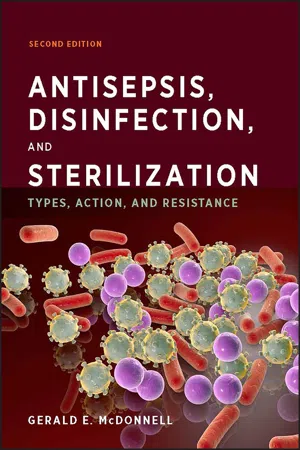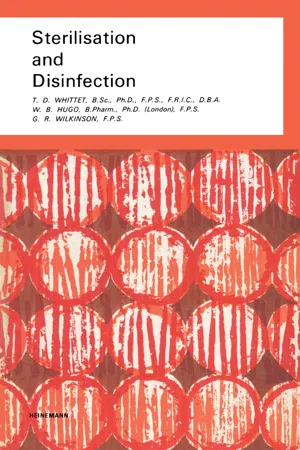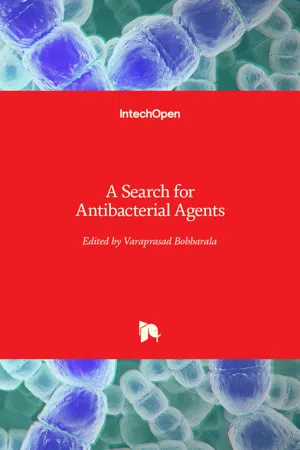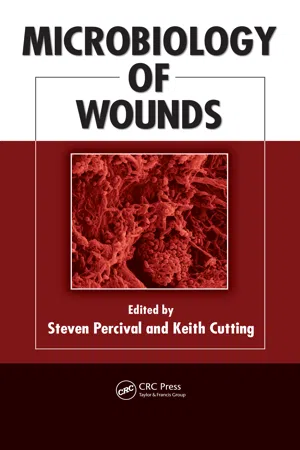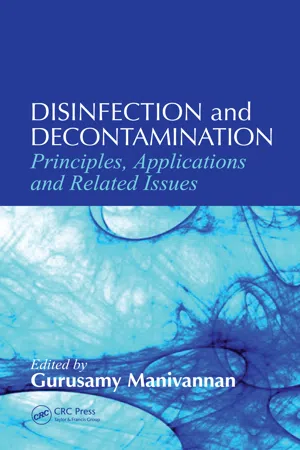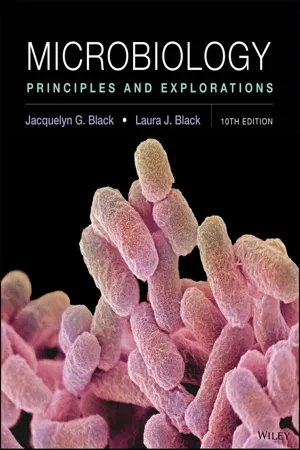Biological Sciences
Antiseptic
Antiseptic refers to a substance that inhibits the growth and development of microorganisms, particularly those that cause infection. It is commonly used to clean and disinfect wounds, as well as to sterilize medical equipment. Antiseptics are designed to be applied to living tissues and are generally less harsh than disinfectants, making them suitable for use on the skin and mucous membranes.
Written by Perlego with AI-assistance
Related key terms
1 of 5
6 Key excerpts on "Antiseptic"
- eBook - ePub
Antisepsis, Disinfection, and Sterilization
Types, Action, and Resistance
- Gerald E. McDonnell(Author)
- 2017(Publication Date)
- ASM Press(Publisher)
4 AntisepticS AND ANTISEPSIS4.1 INTRODUCTION
Antiseptics can be defined as biocidal products that destroy or inhibit the growth of microorganisms in or on living tissue, e.g., on the skin. In theory any biocide or biocidal process could be used on the skin or mucous membranes, although only a limited number are widely used. Living tissues are more sensitive to damage than hard surfaces; therefore, the requirements for the safe use of Antiseptics restrict the choice to those that have limited or no toxicity. Antiseptics can include a variety of formulations and preparations, such as antimicrobial hand washes, surgical scrubs, preoperative preparations, ointments, creams, tinctures, mouthwashes, and toothpastes. Overall, Antiseptics should demonstrate the following characteristics- A wide spectrum of biocidal activity, particularly against bacteria, fungi, and viruses
- Rapid biocidal activity
- Little or no damage, irritation, or toxicity to the tissue
- Little or no absorption into the body
- If possible and applicable, some persistent biocidal (or biostatic) activity (many biocides used in Antiseptics remain on the skin following washing or application, allowing continuing biocidal and growth-inhibitory action or cumulative activity over time)
4.2 SOME DEFINITIONS SPECIFIC TO AntisepticS
- Antimicrobial soap: A soap- or detergent-based formulation that contains one or more Antiseptic agents at concentrations necessary to inhibit or kill microorganisms.
- Antisepsis
- eBook - PDF
Sterilisation and Disinfection
Pharmaceutical Monographs
- T. D. Whittet, W. B. Hugo, G. R. Wilkinson, J. B. Stenlake(Authors)
- 2013(Publication Date)
- Butterworth-Heinemann(Publisher)
Clearly, if an environment is to be made free from the ability to reinfect, its bacterial population must be destroyed. Antiseptic. This term means against sepsis, which in general means wound infection. A bacteriostatic agent may prevent sepsis developing in the body especially if the normal body defences against sepsis are operative. Another common usage of the terms disinfectant and Antiseptic is to use the former for preparations to be applied to inert sur-faces and the latter to preparations for application to living tissues. Many of the standard works include only the word disinfection in their title yet deal with all classes of compounds and with a wide range of application. It is unrewarding to be too dogmatic about these terms; many substances can function in both capacities depending upon their concentration and time of contact. The term disinfection is used as a heading to this monograph to em-brace all aspects of the chemical control of micro-organisms other than by antibiotics, and other chemotherapeutic agents. The Concept of Bacteriostasis It is doubtful if there is a difference other than degree between bacteriostatic and bactericidal action. The three situations, growth, 189 STERILISATION A N D DISINFECTION bacteriostasis and killing are represented graphically in Fig. 1. The question posed by this notion, however, to which often there is no precise answer, is, how long will a culture of bacteria remain viable when preventedfrom reproducing. Hugo^ound thatwashed suspensions of Esch, coli suspended in quarter strength Ringer's < < < B A C T E R I O S T A S I S Ο Ο F I G . 1. The fate of a bacterial population when inoculated into: A. Nutrient medium. Normal growth curve. B. Bacteriostatic environment. No change in viable population. After a prolonged time-interval the viable population will probably begin to fall. C. Bactericidal environment. A sigmoid death curve is shown. - eBook - PDF
- Varaprasad Bobbarala(Author)
- 2012(Publication Date)
- IntechOpen(Publisher)
11 Bacteriostatic Agents Marzieh Rezaei 1 , Majid Komijani 1 and Seyed Morteza Javadirad 2 1 Department of Biology, Faculty of Science, Nour Danesh Institute of Higher Education, Hafez St., Meymeh, Isfahan, 2 Genetic Division, Biology Department, Faculty of Sciences, University of Isfahan, Isfahan, 1,2 Iran 1. Introduction In this chapter we begin to study the effect of the antibacterial agents used for control of microbial growth There are some essential related terms for studying the antibacterial agents that are mentioned as in following: a. Biocide : A widespread chemical or physical agent which inactivates microorganisms. b. Bacteriostatic : property of a specific biocide agent which is able to bacterial multiplication. c. Bactericida l: A specific term referring to the property by which a biocide is able to kill bacteria. d. Disinfectants : Products or biocides used to reduce only the number of viable microorganisms on the inanimate objects e. Septic : Characterized by the presence of pathogenic microbes in living tissue. f. Antisepti c: A biocide or product that inhibits the growth of microorganisms in or on living tissue. g. Aseptic : Free of or using methods to keep free of, microorganisms. h. Antibiotics : Naturally occurring or synthetic organic compounds which inhibit or destroy selective bacteria, generally at low concentrations. i. Sterilization : is defined as the process where all the living microorganisms, including bacterial spores are killed. Sterilization can be achieved by physical, chemical and physiochemical means. j. Asepsis is the employment of techniques (such as usage of gloves, air filters, uv rays etc) to achieve microbe-free environment. Large numbers of antibacterial agents are of clinical interest. The mechanisms by which compounds with antibacterial activity inhibit growth or cause bacterial death are varied and depend on the affected targets. - eBook - PDF
- Steven Percival, Keith Cutting(Authors)
- 2010(Publication Date)
- CRC Press(Publisher)
Some definitions of relevant terms with suitable examples are provided in Table 11.1. Reducing microbial load in vivo relies on using chemotherapeutic agents that selectively inhibit or kill microbial cells without damaging host cells. A diverse range of agents is available, but in clinical practice Antiseptics and topical antibiotics have most frequently been used for this purpose. Agents used for clinical care should not adversely affect mammalian cells. The efficacy of all disinfectants and Antiseptics is influenced by many factors, including their concentration, temperature, and contact time; the types and numbers of microbial cells present; and the presence of other organic matter. Treating invasive wound infections usually requires using systemic (oral or parenteral) antibiotics, most of which are different than those used topically. Some antibiotics are bacterostatic but most are bactericidal; the advantage of the lat-ter is mainly limited to treating patients who are immunocompromised or in selected Biocide A chemical that is able to kill or inhibit the growth of microorganisms Disinfectant • Synthetic (e.g., phenol) hypochlorites • Destroy microorganisms and spores found on non-living objects • Broad sp ectrum of activity • Non-sele ctive • Cytotoxic • Resistance risk lower than fo r antibiotics Antibiotic • Natural ( e.g., penicillin G) or sometimes, semi-synthetic or synthetic (e.g., cephalosporins) • Ability to be transported by the blood and lymphatic system • Selective • Cytotoxic • Sp ecific activity (e.g., cell wall synthesis, protein synthesis) • Resistance risk high Antiseptic • Synthetic (e.g., iodine, silver) • Can be applied to living tissue/skin to reduce the possibility of infection • Broad sp ectrum of activity • Non-sele ctive • Low cytotoxicity at low concentrations • Resistance risk lower than fo r antibiotics FIGURE 11.2 Biocide overview. Antimicrobial Interventions for Wounds 297 severe infections such as endocarditis or meningitis. - eBook - PDF
Disinfection and Decontamination
Principles, Applications and Related Issues
- Gurusamy Manivannan(Author)
- 2007(Publication Date)
- CRC Press(Publisher)
Although adequate in many instances, its efficacy is not sufficient in some, especially when Proper Use of Disinfectant and Antiseptic Agents in Healthcare Settings 141 dealing with certain antibiotic-resistant pathogens or in high-risk areas. Antiseptic hand wash refers to the same procedure, when an Antiseptic agent is added to soap (antimicrobial soap). This action is often referred to as chemical removal of microorganisms, because Antiseptic agents kill or inhibit the growth of microorganisms. However, frequent handwashing is potentially damaging to skin, time consuming, and expensive [81]. So, Antiseptic hand rub is considered to be the most effective way of breaking the chain of transmission of microorganisms [48]. That is rubbing of all surfaces of the hands with small amount (3–5 ml) of, usually, an alcohol-containing preparation until dry or for a preset duration recommended by the manufacturer. The purpose of this action is to eliminate, as quickly as possible, microorganisms that survive on hands after contact with a con-taminated object or colonized = infected patient. This method ensures that the concerned persons do not develop an infection and that contamination will not be transmitted from their hands to other patients. Surgical hand antisepsis refers to Antiseptic hand wash or Antiseptic hand rubs performed preoperatively by members of surgical team who have direct contact with the sterile operating field, or sterile instruments, or supplies used in the field. The purpose of these actions is to prevent the transfer of microorgan-isms from members of the surgical team to the operation site, and to ensure that even if the surgical gloves become perforated during the operation, only few microorganisms from the hands will be implanted in to the surgi-cal site. This means that transient flora as well as resident flora should be reduced, and that this reduction should last during the operation, for several hours. - eBook - PDF
Microbiology
Principles and Explorations
- Jacquelyn G. Black, Laura J. Black(Authors)
- 2018(Publication Date)
- Wiley(Publisher)
When properly carried out, sterilization procedures ensure that even highly resistant bacterial endospores and fungal spores are killed. Much of the controversy regarding spontaneous generation in the nineteenth century resulted from the failure to kill resistant cells in materials that were thought to be sterile. PRINCIPLES OF STERILIZATION AND DISINFECTION 330 The Control of Microbial Growth 331 CHEMICAL ANTIMICROBIAL AGENTS 331 The Potency of Chemical Agents 331 • Evaluating the Effectiveness of Chemical Agents 332 • Disinfectant Selection 333 • Mechanisms of Action of Chemical Agents 333 • Specific Chemical Antimicrobial Agents 335 CHAPTER MAP PHYSICAL ANTIMICROBIAL AGENTS 341 Principles and Applications of Heat Killing 341 • Dry Heat, Moist Heat, and Pasteurization 342 • Refrigeration, Freezing, Drying, and Freeze-Drying 344 • Radiation 346 • Sonic and Ultrasonic Waves 348 • Filtration 348 • Osmotic Pressure 350 • In the Future 351 In contrast with sterilization, disinfection means reducing the number of pathogenic organisms on objects or in ma- terials so that they pose no threat of disease. Agents called disinfectants are typically applied to inanimate objects, and agents called Antiseptics are ap- plied to living tissue. A few agents are suitable as both disinfectants and Antiseptics, although most disinfectants are too harsh for use on delicate skin tissue. Antibiotics, though often applied to skin, are considered separately in ▶ Chapter 14. Terms related to sterilization and disin- fection are defined in Table 13.1. Follow the Chapter Map to help you pinpoint the core concepts in the chapter. Microbes in Space Never a problem for Han Solo, but in the real world of space travel, bacteria carried by astronauts are of real concern. Some of the problems include infectious dis- eases, allergy to microbial metabolites, and microbial deterioration of structural materials.
Index pages curate the most relevant extracts from our library of academic textbooks. They’ve been created using an in-house natural language model (NLM), each adding context and meaning to key research topics.
